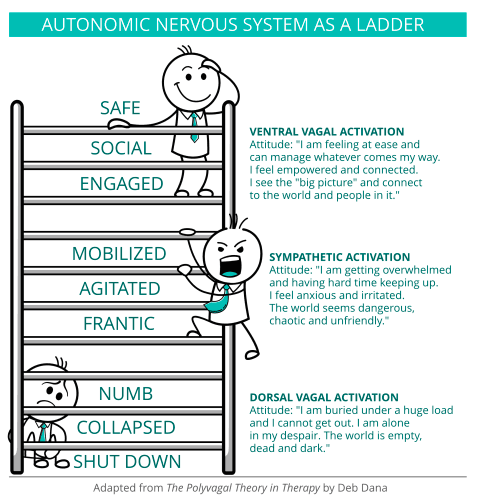Polyvagal theory is a framework through which to understand how our autonomic nervous system’s overarching function of keeping us safe profoundly affects our day to day experience. How safe or unsafe we feel moment to moment changes our reactions, thoughts and behavior, and how our body functions [9].
Polyvagal theory has 3 foundational principles:
- HierarchyWe move between the 3 nervous system states in a predictable order: VVC to sympathetic to DVC and vice versa, so to go from DVC to VVC a person has to move through sympathetic activation.
- NeuroceptionWe are constantly scanning our internal and external environments for cues of danger and safety. When we pick up cues of danger, we move into a state of mobilization, when we pick up cues of safety we move into a state of safety and connection.
- Co-regulationThe most effective way for someone’s nervous system to come back into a state of safety is through connection to a regulated other. We find safety (and therefore regulation) in sociality [2].
When our VVC is activated, we feel safe and we can connect to others and ourselves. Our resources are mobilized towards connection and growth. Being in this state is often referred to as having a regulated nervous system.
When something threatens this safety our sympathetic nervous system is activated and we move into a state of mobilization. This is also known as fight or flight.
When the state of fight or flight gets overwhelmed, like we can’t defeat or escape the threat, our DVC is activated and we move into a state of immobilization or shutdown.

Being in a state of sympathetic activation or DVC activation is often referred to as having a dysregulated nervous system. When we are in a dysregulated state our body’s resources are utilized for self-protection, versus connection, growth, learning, or repair.
Ideally, we want to spend most of our time in the state of safety and connection, moving into and out of mobilization and shutdown when needed. A healthy autonomic nervous system is not one that is calm all the time; it is one that can respond and move appropriately.
We experience persistent physical stress and are at a higher risk of developing physical and mental illness if we stay in a dysregulated state for a prolonged period of time [9].
Finding regulation within our nervous systems is often complicated for those of us who have had unsafe experiences with other people, especially if those people were caregivers or loved ones during early life or as an adolescent. Developmental trauma causes changes in the brain that may lead to a hypersensitivity to danger and a reduced ability to come back to a sense of safety due to having difficulty with coregulation [2][8].
Our autonomic nervous system is “shaped by our early experiences and reshaped by ongoing experiences” [2]. We learnt to react the way we do based on our past experiences, and we can learn new ways to react. Our nervous system learns by experience, not by being told. To change the way we react and experience our lives, we need to make choices that show our nervous system that we are safe. Through this we can renegotiate adverse life experiences. This isn’t a quick process; it is an ongoing way of interacting with the world and ourselves [2][8][9].


